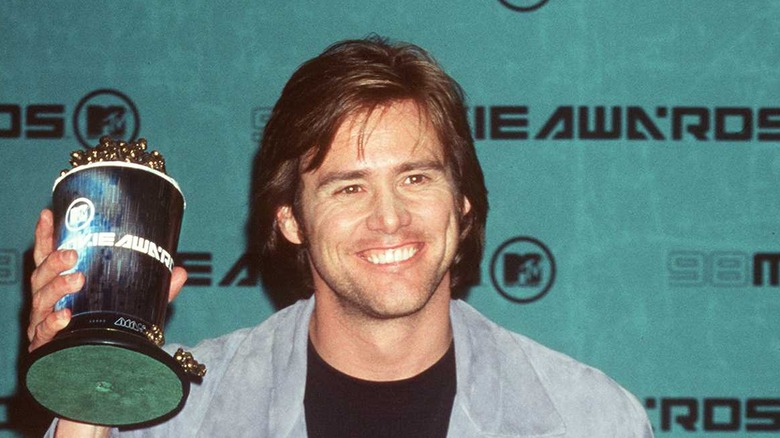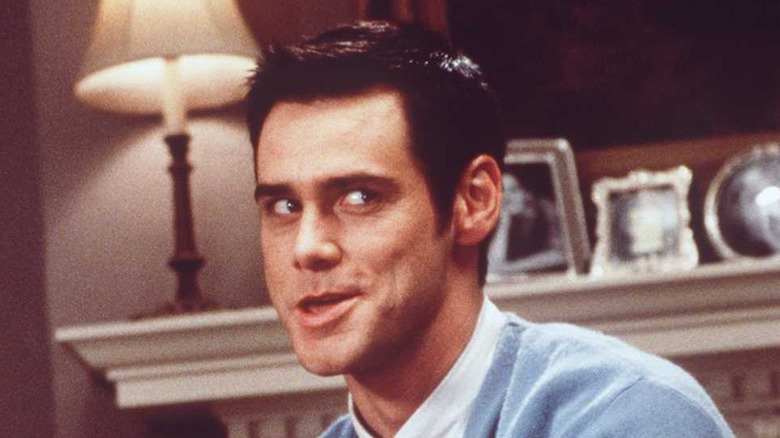Here's How Much Jim Carrey Is Actually Worth
We may receive a commission on purchases made from links.
There was a time when movie audiences really seemed like they just couldn't get enough of actor and comedian Jim Carrey. In fact, in 1994 Carrey enjoyed the delirious success that comes with having three major movies — "Ace Ventura: Pet Detective," "The Mask," and "Dumb & Dumber" — gross millions of dollars around the world and enjoy the number one spot in theaters for weeks (per Uproxx).
That was certainly a lofty height for a man who had been homeless following his father's job loss when he was only twelve. He and his family tried to make ends meet by picking up work as janitors, and it took years for Carrey's stand-up comedy career to take off once he moved to Los Angeles. In fact, it would take the Wayans Brothers comedy show "In Living Color" to really set things into motion for the star, but once his career took off, there was no going back.
Here's a look at a man who has brought smiles to our faces and joyful tears to our eyes for decades, and just what it took to help him earn the estimated $180 million that Celebrity Net Worth claims is all his.
Jim Carrey was homeless when he was only 12 years old
It's hard to believe now that he is one of the most successful people in Hollywood, but Jim Carrey and his family were homeless when he was only 12 years old. As Carrey told CBS, his father, a former saxophone player-turned-accountant, lost his job at the time, and the whole family was nearly immediately put to work. Carrey picked up a job as a janitor alongside his father and siblings, but even as a child, he often turned to comedy to keep his mother's spirits up. As he told CBS, his mother was "sick and sad." He said, "I wanted to make her feel better. And I used to go in there and do impressions of praying mantises, and weird things, and whatever. I'd bounce off the walls and throw myself down the stairs to make her feel better."
Carrey also admitted that he harbored anger at the world for the position his family was in. Their living conditions were dire, and Carrey said it was really tough for him to absorb and deal with. As he explained, "We were experiencing poverty at that point. We all got a job, where the whole family had to work as security guards and janitors. And I just got angry."
Rodney Dangerfield helped Jim Carrey break into stand-up comedy
At the age of 17, Jim Carrey was struggling to get by while working at comedy clubs in Toronto, Canada. In addition to supporting himself, he had his parents and his siblings to think about. He eventually moved on to working clubs in Los Angeles. His first ex-wife would later claim that during this time period, she supported the pair exclusively; Melissa Womer said that while she worked two jobs to keep things afloat, Carrey was only bringing home $150 a week (per The Spokesman-Review).
All this changed when Jim Carrey met comedian Rodney Dangerfield. As Carrey later recounted to Jimmy Fallon on "The Tonight Show," Carrey's parents used to pay him $1 to do impressions of Dangerfield for their entertainment (per HuffPost). Dangerfield invited Carrey to join his tour at Caesar's Palace, a move that completely changed the game for the burgeoning comedian.
Carrey penned the foreword in Dangerfield's 2004 autobiography, "It's Not Easy Bein' Me," and he referenced that time period in both of their lives. As he writes, joining the tour was a massive turning point. He explains, "That was a very big deal for me, a huge break" (via Goliath).
He quickly joined the cast of In Living Color
From that point on, Jim Carrey's career was on the ascent. In 1990, he joined the cast of "In Living Color," a move that he would later cite as transformative. In December 2019, Carrey praised the show's creators, explaining on Twitter that "brilliant Black minds gave me a shot in Hollywood when none of the white guys thought I could connect or be a leading man."
While speaking to BlackTree TV, Carrey elaborated on the personal impact of the experience. As he put it, "It was the thing, basically. There was a lot of work that went into that, but that was the doorway." According to Celebrity Net Worth, the show as also his first big pay day: Carrey earned $25,000 per episode.
Carrey has even argued that the show's massive cultural impact extends all the way to the Super Bowl halftime show, which he believes the show changed completely. In 1992, Fox decided to put a live episode of the show on the air at the same time as the annual football game. As Complex notes, the response from the Super Bowl was swift: The following year, Michael Jackson was booked to perform at halftime. As Carrey told BET, "If you'll remember, I believe it was the very next year they had somebody like Michael Jackson on the halftime show. Until then, it was marching bands and whatever, right? It definitely pushed it to another level."
1994's Ace Ventura: Pet Detective made Jim Carrey a star
In 1994, Jim Carrey accomplished a feat that some believe may never be repeated again. He was catapulted into massive fame with the release of "Ace Ventura: Pet Detective" that year, and then quickly turned around and followed up that wildly successful film with two more: "The Mask" and "Dumb & Dumber." For a time, it seemed you couldn't turn around without seeing Carrey's face on a film poster, and all those movies resulted in a massive pay-off for the rising star.
As Uproxx later recounted, "Ace Ventura" shot to the number one spot the weekend of February 6, 1994, and it remained there for several of the following weeks. The movie ended up netting $107 million around the world, which means its $15 million production cost wasn't a big deal at all. Only months later, "The Mask" hit number one in theaters and managed to pull in $351 million. "Dumb & Dumber" debuted toward the end of the year, pooling in a cool $247 million all on its own.
Carrey told famed film critic Roger Ebert he wasn't sure what to expect from "Ace Ventura," especially as critics weren't especially kind. As he said, "Yeah, some of the reviews were pretty brutal. You know what? Some of the worst ones came in a couple of days before the movie opened and I thought, well, this is keeping my feet on the ground."
He bought his first home for $4 million in 1994
All that success meant that for possibly the first time in his life, Jim Carrey had plenty of money and was ready to spend it. As such, he turned around and made a reasonable purchase: his first home. That initial purchase only cost him $3.8 million, and as noted by Celebrity Net Worth, Carrey has steadily added on to the now-massive compound over the years. In 2000, he paid nearly $2 million for the lot next door.
In the years that have followed, Carrey has bought and sold several properties. He most notably offloaded his Malibu beach home for $13.4 million in 2013. At the time, "Today" noted that the star had previously tried and failed to sell the house for $18 million in 2011. Despite having to drop the sale price to $13.4 million in the end, Carrey still came out ahead: He only paid $9.75 million when he bought the home in 2002.
His 1995 divorce didn't set him back too much financially
Jim Carrey has been married twice. He met his first wife, Melissa Womer, after moving to Los Angeles to pursue a career in stand-up comedy. At the time, she said she supported the two of them as Carrey tried to make a career in comedy work, often bringing home only $150 a week (per The Spokesman-Review).
The pair ended up divorcing a few years later, right before Carrey hit it big after signing a contract to star in "The Mask." In doing so, Carrey also managed to avoid owing Womer a huge sum of the money he received for the film. As she told The Spokesman-Review, Carrey named the date of their separation as June 15, 1993 — the day he signed a contract for $7 million. Per California law, Carrey would only be required to split any income he earned prior to their separation date.
The publication notes that the settlement Carrey offered Womer — a one-time payment of $500,000 and $25,000 a month in alimony and child support for their daughter — was a far cry from the numbers he was commanding from his work on screen.
In 1998, Jim Carrey earned $20 million for The Cable Guy
In 1998, Jim Carrey enjoyed what would become yet another banner year in terms of financial gains from his career. He took home a massive $20 million paycheck for "The Cable Guy," and maintained that rate for several films that followed, including "Batman Forever," "Liar Liar," "Me, Myself & Irene," and "How the Grinch Stole Christmas" (per Celebrity Net Worth).
However, even that great height would not come close to the whopper of a paycheck that Carrey earned in a risky business decision for the film "Yes Man." As The Wall Street Journal shared at the time, Carrey opted to take a back-end deal for the picture, which meant he would earn zero dollars at the outset of the film's production but would be in possession of a 33% stake in the film's overall earnings. In the end, this meant he took home $35 million for a movie that he technically agreed to do for free. The publication notes, "The film was a success, but didn't perform as well as the studio had expected. Still, Mr. Carrey made about $35 million off the deal — roughly $5 million more than he would have made had he not forfeited his fee."
As Celebrity Net Worth has shared, this was one of the 30 largest checks in cinematic history.
A 2013 wrongful death lawsuit against Jim Carrey was dismissed
In 2016, People revealed that Jim Carrey was hit with a wrongful death lawsuit filed by the estranged husband of his former girlfriend, Cathriona White, who took her own life the year before. White's mother, Bridget Sweetman, was also a party on the suit filed by Mark Burton. The pair claimed that Carrey was responsible for giving White the drugs that ultimately ended her life.
The suit was eventually dismissed, but not before Carrey filed his own countersuit against the pair. Carrey also claimed that White's lawyer, Filippo Marchino, had previously tried to extort money from him after falsely claiming that he gave White sexually transmitted diseases in 2013 (via People).
While it is likely the legal battle that Carrey waged against White, her husband, and her mother was costly over the years, the fact that the case was dismissed likely means the suit never approached anything close to financial ruin for the comedic star. Despite their ups and downs, People noted that Carrey's statement about White following her death was only kind and loving. He wrote, "She was a truly kind and delicate Irish flower, too sensitive for this soil, to whom loving and being loved was all that sparkled."
Jim Carrey's career has slowed down in recent years
Enjoying tremendous success in the early part of his career has meant that Jim Carrey has been able to intentionally slow things down as he gets older. This is by design, with Carrey telling The Hollywood Reporter that it wasn't that the industry grew tired of him — he grew tired of it. He told the publication that eventually, he grew jaded by Hollywood completely, and knew that he wanted to get out. As he put it, "I didn't like what was happening, the corporations taking over and all that. And maybe it's because I felt pulled toward a different type of creative outlet and I really liked the control of painting — of not having a committee in the way telling me what the idea must be to appeal to a four-quadrant whatever."
In 2018, Carrey starred in Showtime's "Kidding," but he was quick to note that this wasn't a permanent comeback. In fact, at the same time Carrey seemed much more focused on spending his time illustrating political cartoons on Twitter, The Hollywood Reporter also shared that the pastime was one that delighted the star.
Audiences were delighted when Carrey was cast in 2020's "Sonic the Hedgehog," and Carrey seems to be equally delighted by his role as Doctor Eggman (per Parade).









